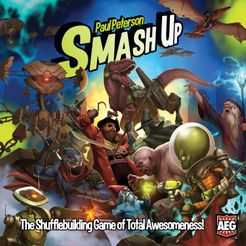
BACKGROUND: Smash Up is a card game for 2-4 players, and was designed by Paul Peterson and published by Alderac Entertainment Group. It describes itself as a "shufflebuilding", where players take 2 seperate types of characters, like Faries and Dinosaurs, and shuffles them together to invade locations and prove they are the best pair of all.
GAMEPLAY: Each player chooses 2 factions and shuffles their decks together. Then the number of players +1 Bases are put out in the center of the table. Each turn, a player may play up to 1 Minion on a base, and up to one Action card. Minions are always played on a base, whereas Action cards may be played on a Minion, a Base, or just played. Some cards may be played in addition to these actions, such as discarding them to give their effect, and some have Talents, which can be used once per turn during the card play phase. Any card still not in play is discarded.

BASES: Bases have 3 large numbers in the center, and a smaller number in the top left, as do minions. At the end of a players turn, when the number on all the Minions in a base are equal to or higher than the bases smaller number, the base is discarded, generally with the player with the higher number total on the base scoring Victory Points (VP) equal to the left large number, the 2nd most scoring the middle number, the 3rd scoring the right number, and other players scoring nothing. Some bases have effects which change the play style. Finally, the base is discarded and replaced, and all cards on the base are sent to their players' respected discard piles.

WINNING: The first player to get 15 or more VP ends the game, with the winner being the player with the most VP.
CONCLUSION: Smash Up is probably one of the hardest games to both explain and get a good grasp on in terms of card games. There's a huge, complex, delicate strategy constantly going on may an usually will need to be changed in the drop of a hat. Even in the base form, it can be a struggle to get your plans to work, not to mention that with the inclusion of close to 15 expansions and 60 separate factions, there's a lot to play with and remember. Smash Up can still be quite enjoyable, but this is the game that you play with your gaming friends on a Friday night, not your relatives who are just starting to learn board games, or the ones whose most advanced game is Dominoes. Still, it's a lot of fun to Smash Up a few factions and see which ones come out on top.



/pic1363812.jpg)
/pic1239564.jpg)
/pic4216110.jpg)
/pic4243174.jpg)
/pic4285197.png)